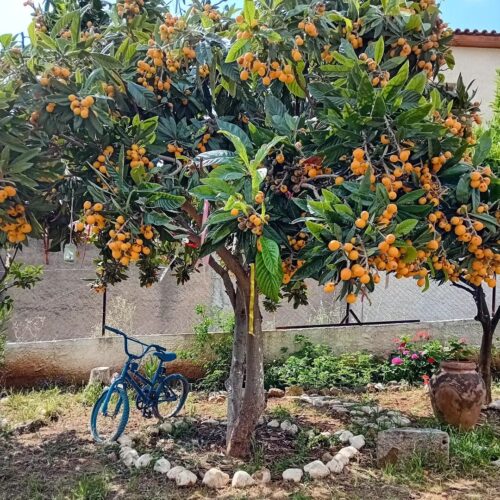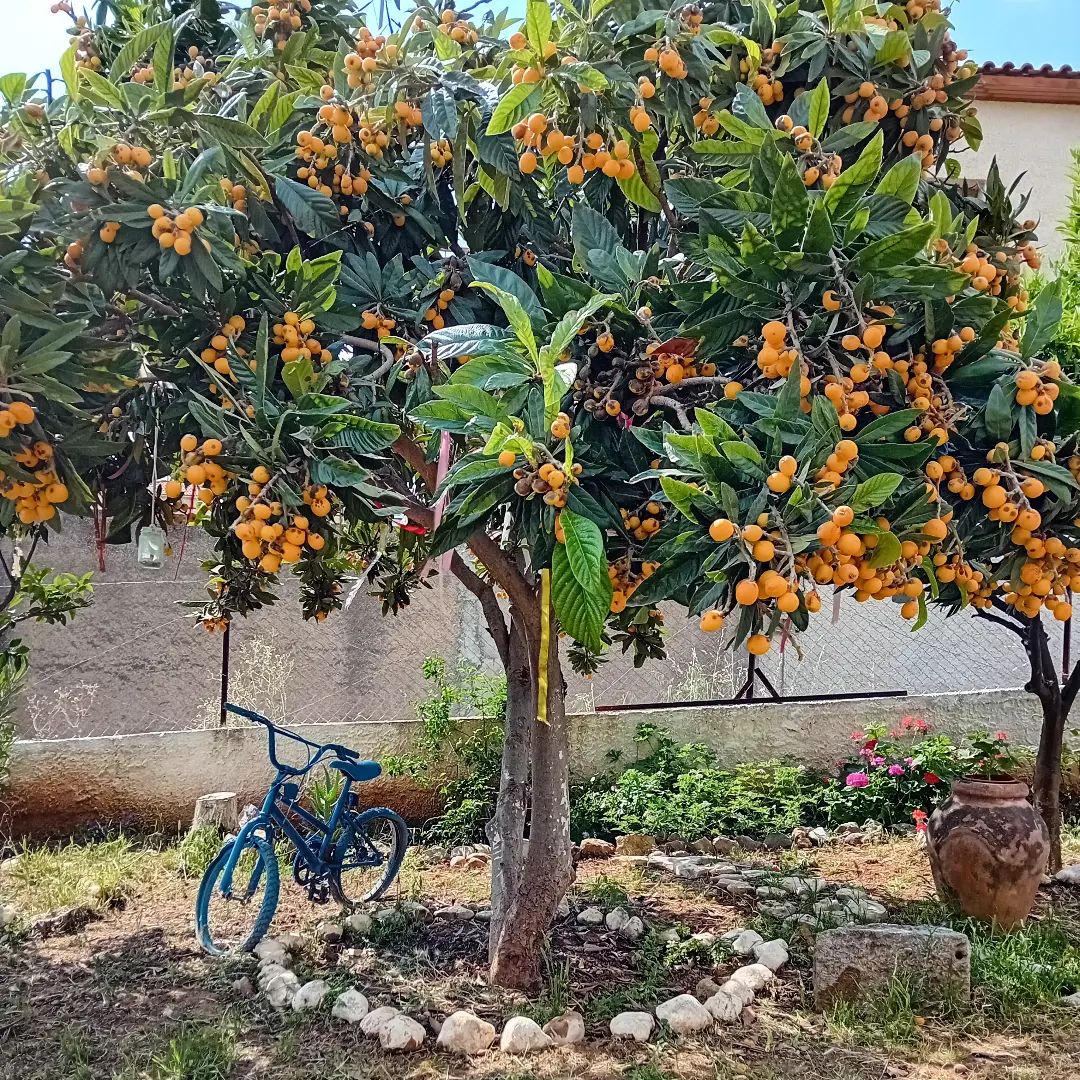Are you in love with Loquat, the Japanese Medlar, or the Japanese Plum? Learn How to Grow a Loquat Tree in our article here.
Loquat is a unique tree to grow in your garden, most prized for its delicious offerings and beauty. It flowers in fall and bears fruit from late winter to early spring. Know everything about it in our guide on Loquat Tree Planting.
Loquat Tree Information

Loquats are native to China, carefully grown in Japan, and loved most in America. Eriobotrya Japonica can grow to 20-25 feet in height upon reaching maturity and spread to 15-20 feet in width.
Loquat tree produces clumps of delicate blooms with a sweet, strong fragrance. It bears pear or round-shaped fruits in yellow or orange that are 1-2 inches long. The white, yellow, or orange flesh can be slightly acidic or sweet. The sweet-tangy flavor can remind you of other fruits like lemon, apricot, grape, cherry, and such.
E. Japonica belongs to the pome family and is a cousin of apples, pears, and quinces. With juicy and firm fruit, it contains 2-3 big seeds in dark brown. The evergreen tree thrives well in USDA Zones 8-10.
Loquat Tree Planting
Growing a loquat tree starts with its proper planting.
When planting it, you should pick a spot for the trees at a sunny location at least 20-30 feet away from any concrete structures, other trees, electrical lines, and such.
After removing the sapling from the containers, wash off the excess dirt so that when you plant it, the roots get in contact with the soil directly. Plant the loquat tree in the soil line of the tree that should be even with the surrounding soil level.
After planting, water the tree 2-3 times in the first week. You should keep the soil evenly and slightly moist around the tree until it sprouts new growth.
The right kind of care for the loquat trees like weed control, water management, good nutrition, and such will take care of the nutrition level of the fruits.
Using a lawn fertilizer, you should fertilize the trees 3-4 times a year. Use a cup of fertilizer to feed the trees thrice a year in the first year. Apply water to the trees slowly to allow the fertilizer to sink into the soil.
Varieties of Loquat Tree
Although there are several orange or white-fleshed varieties of Loquat, here are some of the popular cultivars from the United States:
1. Vista White
With pale yellow skin and white flesh, it is a round variety that is small to medium in size and requires another tree to cross-pollinate.
2. Gold Nugget
This is a firm fruit with orange flesh and yellowish-orange skin. It is round to oblong in shape and self-fertile.
3. Early Red
It is a variety with orange flesh and dotted orange-red skin in white. It is medium to large and also self-fertile.
4. Champagne
It is a variety of white to yellow-colored flesh, and the fruits are shaped like pears. With yellow-orange skin, it is a medium to large fruit in size that is self-fertile.
5. Big Jim
This variety comes with pale orange-yellow skin and orange flesh. The large fruit is also self-fertile.
How to Grow Loquat
Propagating Loquat via seeds is usually not recommended, as seedlings do not grow well from seeds. The seeds can quickly germinate as long as they do not dry out. To divide this tree using cuttings, follow the following steps:
- Add 1-2 handfuls of sphagnum peat moss in a bowl filled with water. Allow the moss to soak up.
- Spot a healthy, green stem with many leaves. Pluck out the foliage starting to form the tip and pick a 6-8 inch stem section. Let the twig be attached to the tree for now.
- Scratch off the bark for 1-2 inches in the middle using a small knife as the new roots will sprout from here.
- Use rooting hormone to dust the cut piece of wood.
- Cut a piece of plastic film that should cover the cut section and keep it protected.
- Now, squeeze out the sphagnum peat moss and drain the excess water. Put it over the stem cutting and then cover it with the plastic. Wrap up a twist tie to keep the moss from falling off.
- After the new roots fill up the sphagnum peat moss, cut the twig off the guardian tree. Usually, the twig will take about 25-35 days to form a dense root system.
- Untie the cutting and uncover the plastic. Then, thoroughly plant the cutting in a pot with good-quality soil and water.
- Take care of the loquat tree as usual. Feed and water it on a regular schedule.
Requirements for Growing Loquat Tree
Light
Loquat tree needs full, direct sunlight to partial shade and works best in USDA Zones 8-10. You can grow this tree as a shade cover for your deck, patio, or big containers. Plant loquat trees in a spot that receives 5-8 hours of full, direct sunlight for best growth and fruit production.
Soil
Loquat trees thrive well in a wide range of well-drained soils. However, they are not tolerant of overwatered or flooded conditions. It does well in clay, gravelly limestone-based soil, and rich, loamy soils.
Water
For the first 2-3 weeks, you need to water the loquat trees 3-4 times a week and then eventually slow down the watering frequency until it is established.
The loquat trees planted in the garden work best if it receives 20-45 inches of rainwater every year.
When the tree begins to flower and fruit, you should water it very slowly to allow the tree to absorb as much as possible.
You can mulch around the base of the tree during the summer months as it can keep the moisture in the soil and let the tree make the most use of it.
Temperature
These trees are extremely cold tolerant and can withstand temperatures as low as 8-10°F or -10-13°C. However, the fruits and flowers can get killed by temperatures below 27°F − or -3°C. It becomes impossible to bear fruits if the temperatures drop below 30°F or -1°C.
If you are growing them in pots, you can move them indoors when it becomes too cold for the fruits and flowers. In temperatures above 95°F or 35°C, the loquat trees can suffer from leaf scorch and go under stress. Water the tree in the summers more adequately to compensate for the stress of rising temperatures.
Humidity
Loquats naturally grow in much more humid conditions in 40-60 percent of their native Asian environments than in the desert of California or the southwestern part of the USA. Though, you may be able to find some cultivars that can work well in low levels of humidity.
Loquat Tree Care
Fertilizer
Loquat trees need regular fertilization to grow and thrive best. Feed the young trees in the first year with a quarter of a pound of granular, slow-release, 6:6:6 (NPK) fertilizers once every 50-60 days. For organic gardens, you can use 1-2 tablespoons of rock phosphate, 1-2 tablespoons of greensand, and 2-3 pounds of aged manure during the growing season.
Pruning
Prune the loquat trees once every 2-3 months during the first 2-3 years of their growth. Cut off the growing tips on all branches to maintain them at a shorter height of 2-3 feet. It forces the trees to sprout more branches, meaning it has more growing surfaces to bloom and fruit.
Get rid of the dead branches to keep the loquat trees healthy. The container-grown ones can grow up to 1-2 feet in height yearly, and you can prune them to remain smaller and more compact.
Pests & Diseases
Loquat trees are excessively prone to fire blight that the bees can spread. It is more common in zones with higher humidity levels or where the spring comes late. Fire blight can attack the younger shoots and destroy the foliage, too. Watch out for fruit flies, scale insects, aphids, caterpillars, deer, birds, and diseases like pear blight. Talk to an expert to understand the symptoms and deal with the pests and diseases problems.
Harvesting
You can pick your ripened fruits once they become larger than the unripened ones. The skin of the ripe loquat fruits is slightly darker than the unripe ones. Trim off the branch tip and take down the clumps of loquats all in one go. The slightly under-ripe fruits can taste less juicy and sweet, while the over-ripe ones can taste extremely sweet and mushy.



